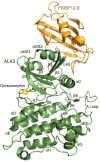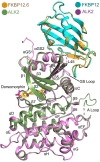ALK2 Receptor Kinase Association with FKBP12.6 Is Structurally Conserved with the ALK2-FKBP12 Complex
- PMID: 33572801
- PMCID: PMC7911104
- DOI: 10.3390/biomedicines9020129
ALK2 Receptor Kinase Association with FKBP12.6 Is Structurally Conserved with the ALK2-FKBP12 Complex
Abstract
The immunophilin FKBP12 is a known inhibitor of type I BMP and TGF-β receptors that competes for binding with their substrate SMADs. FKBP12 and the close paralog FKBP12.6 additionally assemble with ryanodine receptors to control Ca2+ release. Binding of FKBP12.6 to BMP/TGF-β receptors has yet to be investigated, but appears plausible given its high sequence similarity to FKBP12. Here, we found that FKBP12.6 can assemble with BMP and TGF-β-family type I receptors, but not with type II receptors. Cellular immunoprecipitation confirmed similar binding of FKBP12 and FKBP12.6 to the BMP receptor ALK2 (ACVR1), a known target of mutations in the congenital syndrome fibrodysplasia ossificans progressiva (FOP), as well as the pediatric brain tumor diffuse intrinsic pontine glioma (DIPG). SEC-MALS analyses using purified proteins indicated a direct 1:1 interaction between FKBP12.6 and the receptor's cytoplasmic domains. The 2.17 Å structure of this ALK2-FKBP12.6 complex bound to the inhibitor dorsomorphin showed FKBP12.6 binding to the GS domain of ALK2 in a manner equivalent to the FKBP12 complex, with ALK2 residues Phe198 and Leu199 extending into the FK506-binding pocket of FKBP12.6. These findings suggest a level of redundancy in FKBP-family regulation of BMP and TGF-β signaling.
Keywords: ACVR1; ALK2; BMP; FKBP12; FKBP12.6; fibrodysplasia ossificans progressiva; kinase.
Conflict of interest statement
The authors declare no conflict of interest. The funders had no role in the design of this study.
Figures





Similar articles
-
FKBP12 is a major regulator of ALK2 activity in multiple myeloma cells.Cell Commun Signal. 2023 Jan 30;21(1):25. doi: 10.1186/s12964-022-01033-9. Cell Commun Signal. 2023. PMID: 36717825 Free PMC article.
-
Effects of FKBP12 and type II BMP receptors on signal transduction by ALK2 activating mutations associated with genetic disorders.Bone. 2018 Jun;111:101-108. doi: 10.1016/j.bone.2018.03.015. Epub 2018 Mar 15. Bone. 2018. PMID: 29551750
-
ALK2: A Therapeutic Target for Fibrodysplasia Ossificans Progressiva and Diffuse Intrinsic Pontine Glioma.Chem Pharm Bull (Tokyo). 2020;68(3):194-200. doi: 10.1248/cpb.c19-00882. Chem Pharm Bull (Tokyo). 2020. PMID: 32115526 Review.
-
Structure-activity relationship of 3,5-diaryl-2-aminopyridine ALK2 inhibitors reveals unaltered binding affinity for fibrodysplasia ossificans progressiva causing mutants.J Med Chem. 2014 Oct 9;57(19):7900-15. doi: 10.1021/jm501177w. Epub 2014 Sep 4. J Med Chem. 2014. PMID: 25101911 Free PMC article.
-
Development of New Therapeutic Agents for Fibrodysplasia Ossificans Progressiva.Curr Mol Med. 2016;16(1):4-11. doi: 10.2174/1566524016666151222142446. Curr Mol Med. 2016. PMID: 26695699 Review.
Cited by
-
Editorial of Special Issue "Fibrodysplasia Ossificans Progressiva: Studies on Disease Mechanism towards Novel Therapeutic Approaches".Biomedicines. 2022 Jan 10;10(1):140. doi: 10.3390/biomedicines10010140. Biomedicines. 2022. PMID: 35052819 Free PMC article.
-
FKBP12 is a major regulator of ALK2 activity in multiple myeloma cells.Cell Commun Signal. 2023 Jan 30;21(1):25. doi: 10.1186/s12964-022-01033-9. Cell Commun Signal. 2023. PMID: 36717825 Free PMC article.
References
Grants and funding
LinkOut - more resources
Full Text Sources
Other Literature Sources
Miscellaneous

